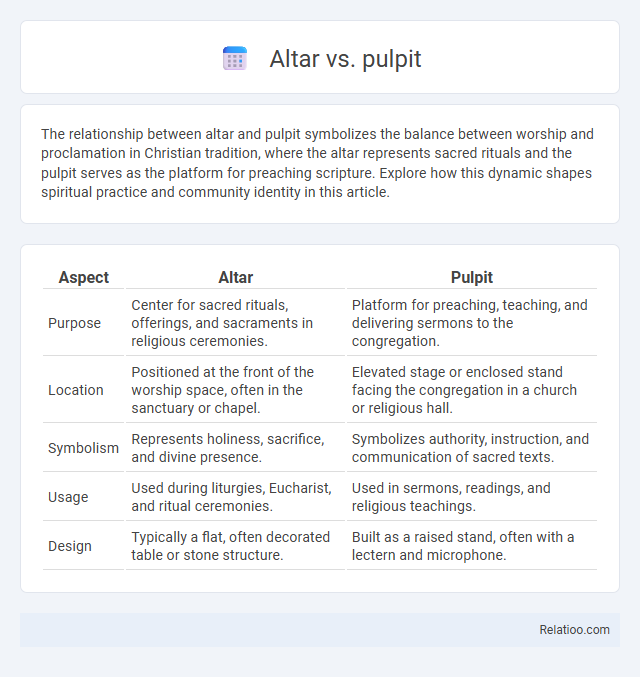The relationship between altar and pulpit symbolizes the balance between worship and proclamation in Christian tradition, where the altar represents sacred rituals and the pulpit serves as the platform for preaching scripture. Explore how this dynamic shapes spiritual practice and community identity in this article.
Table of Comparison
| Aspect | Altar | Pulpit |
|---|---|---|
| Purpose | Center for sacred rituals, offerings, and sacraments in religious ceremonies. | Platform for preaching, teaching, and delivering sermons to the congregation. |
| Location | Positioned at the front of the worship space, often in the sanctuary or chapel. | Elevated stage or enclosed stand facing the congregation in a church or religious hall. |
| Symbolism | Represents holiness, sacrifice, and divine presence. | Symbolizes authority, instruction, and communication of sacred texts. |
| Usage | Used during liturgies, Eucharist, and ritual ceremonies. | Used in sermons, readings, and religious teachings. |
| Design | Typically a flat, often decorated table or stone structure. | Built as a raised stand, often with a lectern and microphone. |
Introduction to Altar and Pulpit
The altar serves as the sacred table in Christian worship, central to the celebration of the Eucharist and symbolic of Christ's sacrifice. The pulpit is a raised platform or lectern from which sermons and scriptures are proclaimed, emphasizing the importance of preaching in the service. Your understanding of these distinct elements enhances appreciation for their unique roles in liturgical settings.
Defining the Altar
The altar is a sacred structure typically found at the center of a church, serving as the focal point for worship and the Eucharistic celebration. Unlike the pulpit, which is used for preaching and delivering sermons, the altar symbolizes the presence of God and is where offerings and sacraments are consecrated. Its design often includes elements such as a flat surface for holding sacred vessels, candles, and a cloth, reflecting its central role in liturgical rites.
Understanding the Pulpit
The pulpit serves as the central platform in a church where sermons are delivered, designed to elevate the speaker for clear visibility and audibility to the congregation. Unlike the altar, which is the sacred table used for communion and symbolizes the presence of Christ, the pulpit emphasizes the proclamation of scripture and teaching. Understanding the pulpit's role helps you appreciate its function in guiding worshippers through spiritual exhortation and scriptural interpretation.
Historical Origins of Altar and Pulpit
The altar, originating in ancient religious practices, served as a sacred space for offerings and sacrifices, symbolizing a direct connection between worshippers and the divine. The pulpit emerged in the early Christian church around the 3rd century as an elevated platform to enhance the audibility and visibility of sermons during liturgical services. Historical origins of the altar emphasize ritualistic significance, while the pulpit highlights the development of preaching and scripture dissemination within ecclesiastical architecture.
Symbolic Meanings: Altar vs Pulpit
The altar symbolizes sacrifice, holiness, and divine presence, often serving as the sacred space for offering prayers and rituals in Christian worship. The pulpit represents the authority of preaching, proclamation of the Word, and spiritual teaching, emphasizing the role of the clergy in guiding the congregation. Together, the altar and pulpit reflect complementary aspects of faith: the altar connecting believers with God's holiness through sacraments, while the pulpit conveys doctrinal instruction and moral guidance.
Roles in Worship Services
The altar serves as the sacred table where the Eucharist or Holy Communion is consecrated and offered during worship services, symbolizing Christ's sacrifice. The pulpit is the elevated platform or lectern from which the preacher delivers sermons, proclaims Scripture, and instructs the congregation. Both the altar and pulpit hold central liturgical roles, with the altar emphasizing sacramental rites and the pulpit focusing on the proclamation of the Word.
Architectural Differences
An altar is typically a flat, horizontal surface used for religious rituals and offerings, often positioned at the front of a worship space. A pulpit is an elevated platform or lectern from which clergy deliver sermons, designed to enhance visibility and acoustics within the architectural layout. Your understanding of these structures highlights that altars emphasize ritual function, while pulpits focus on communication and congregation engagement, each influencing church interior design distinctively.
Denominational Perspectives
Denominational perspectives on altar, pulpit, and ambo differ significantly, influencing worship practices and church architecture. Your faith tradition may emphasize the altar as the central place for Eucharistic celebration, particularly in Catholic, Orthodox, and some Anglican churches, while the pulpit often holds prominence in Protestant denominations where preaching commands attention. The ambo, a raised reading platform commonly found in liturgical churches, bridges these functions by highlighting the proclamation of Scripture within the sacred space.
Contemporary Uses and Adaptations
Contemporary uses of the altar emphasize its role as a sacred space for ritual offerings and symbolic presence in worship, often adapted in modern church designs to be more accessible and visually integrated with congregational participation. The pulpit serves as the focal point for preaching and teaching, frequently designed with enhanced acoustics and technology to support dynamic communication and engagement in diverse worship styles. The distinction between altar and pulpit continues to evolve, with some contemporary churches blending or reinterpreting these elements to reflect theological shifts and community needs, balancing tradition with innovative liturgical expressions.
Conclusion: Altar and Pulpit in Modern Worship
The altar and pulpit serve distinct yet complementary roles in modern worship, with the altar symbolizing sacrifice and communion, while the pulpit represents the proclamation of scripture and preaching. Together, they form the spiritual and theological centerpieces of liturgical practice, emphasizing both the sacramental and the didactic aspects of faith. Understanding their unique functions enriches the worship experience by highlighting the balance between ritual reverence and scriptural teaching.

Infographic: Altar vs Pulpit
 relatioo.com
relatioo.com